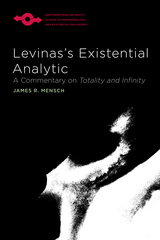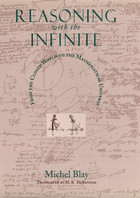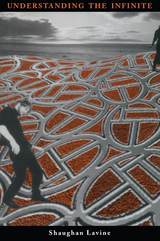5 books about Infinite

Communicating the Infinite
The Emergence of the Habad School
Naftali Loewenthal
University of Chicago Press, 1990
At the end of the eighteenth century the hasidic movement was facing an internal crisis: to what extent should the teachings of Baal Shem Tov and Maggid of Mezritch, with their implicit spiritual demands, be transmitted to the rank-and-file of the movement? Previously these teachings had been reserved for a small elite. It was at this point that the Habad school emerged with a communication ethos encouraging the transmission of esoteric to the broad reaches of the Jewish world. Communicating the Infinite explores the first two generations of the Habad school under R. Shneur Zalman of Liadi and his son R. Dov Ber and examines its early opponents.
Beginning with the different levels of communication in the teachings of the Baal Shem Tov and the Maggid and his disciples, Naftali Loewenthal traces the unfolding of the dialectic between the urge to transmit esoteric ideas and a powerful inner restraint. Gradually R. Shneur Zalman came to the fore as the prime exponent of the communication ethos. Loewenthal follows the development of his discourses up to the time of his death, when R. Dov Ber and R. Aaron Halevi Horowitz formed their respective "Lubavitch" and "Staroselye" schools. The author continues with a detailed examination of the teachings of R. Dov Ber, an inspired mystic. Central in his thought was the esoteric concept of self-abnegation, bitul, yet this combined with the quest to communicate hasidic teachings to every level of society, including women.
From the late eighteenth century onwards, the main problem for the Jewish world was posed by the fall of the walls of the social and political ghetto. Generally, the response was either to secularize, or abandon altogether, traditional Judaism or to retreat from the threatening modern world into enclave religiosity; by stressing communication, the Habad school opened the way for a middle range response that was neither a retreat into elitism nor an abandonment of tradition. Based on years of research from Hebrew and Yiddish primary source materials, Communicating the Infinite is a work of importance not only to specialists of Judaic studies but also to historians and sociologists.
Beginning with the different levels of communication in the teachings of the Baal Shem Tov and the Maggid and his disciples, Naftali Loewenthal traces the unfolding of the dialectic between the urge to transmit esoteric ideas and a powerful inner restraint. Gradually R. Shneur Zalman came to the fore as the prime exponent of the communication ethos. Loewenthal follows the development of his discourses up to the time of his death, when R. Dov Ber and R. Aaron Halevi Horowitz formed their respective "Lubavitch" and "Staroselye" schools. The author continues with a detailed examination of the teachings of R. Dov Ber, an inspired mystic. Central in his thought was the esoteric concept of self-abnegation, bitul, yet this combined with the quest to communicate hasidic teachings to every level of society, including women.
From the late eighteenth century onwards, the main problem for the Jewish world was posed by the fall of the walls of the social and political ghetto. Generally, the response was either to secularize, or abandon altogether, traditional Judaism or to retreat from the threatening modern world into enclave religiosity; by stressing communication, the Habad school opened the way for a middle range response that was neither a retreat into elitism nor an abandonment of tradition. Based on years of research from Hebrew and Yiddish primary source materials, Communicating the Infinite is a work of importance not only to specialists of Judaic studies but also to historians and sociologists.
[more]

Georg Cantor
His Mathematics and Philosophy of the Infinite
Joseph W. Dauben
Harvard University Press, 1979

Levinas's Existential Analytic
A Commentary on Totality and Infinity
James R. Mensch
Northwestern University Press, 2015
By virtue of the originality and depth of its thought, Emmanuel Levinas’s masterpiece, Totality and Infinity: An Essay on Exteriority, is destined to endure as one of the great works of philosophy. It is an essential text for understanding Levinas’s discussion of “the Other,” yet it is known as a “difficult” book. Modeled after Norman Kemp Smith’s commentary on Kant’s Critique of Pure Reason, Levinas’s Existential Analytic guides both new and experienced readers through Levinas’s text. James R. Mensch explicates Levinas’s arguments and shows their historical referents, particularly with regard to Heidegger, Husserl, and Derrida. Students using this book alongside Totality and Infinity will be able to follow its arguments and grasp the subtle phenomenological analyses that fill it.
[more]

Reasoning with the Infinite
From the Closed World to the Mathematical Universe
Michel Blay
University of Chicago Press, 1998
Until the Scientific Revolution, the nature and motions of heavenly objects were mysterious and unpredictable. The Scientific Revolution was revolutionary in part because it saw the advent of many mathematical tools—chief among them the calculus—that natural philosophers could use to explain and predict these cosmic motions. Michel Blay traces the origins of this mathematization of the world, from Galileo to Newton and Laplace, and considers the profound philosophical consequences of submitting the infinite to rational analysis.
"One of Michael Blay's many fine achievements in Reasoning with the Infinite is to make us realize how velocity, and later instantaneous velocity, came to play a vital part in the development of a rigorous mathematical science of motion."—Margaret Wertheim, New Scientist
"One of Michael Blay's many fine achievements in Reasoning with the Infinite is to make us realize how velocity, and later instantaneous velocity, came to play a vital part in the development of a rigorous mathematical science of motion."—Margaret Wertheim, New Scientist
[more]

Understanding the Infinite
Shaughan Lavine
Harvard University Press, 1998
How can the infinite, a subject so remote from our finite experience, be an everyday tool for the working mathematician? Blending history, philosophy, mathematics, and logic, Shaughan Lavine answers this question with exceptional clarity. Making use of the mathematical work of Jan Mycielski, he demonstrates that knowledge of the infinite is possible, even according to strict standards that require some intuitive basis for knowledge.
[more]
READERS
Browse our collection.
PUBLISHERS
See BiblioVault's publisher services.
STUDENT SERVICES
Files for college accessibility offices.
UChicago Accessibility Resources
home | accessibility | search | about | contact us
BiblioVault ® 2001 - 2024
The University of Chicago Press









